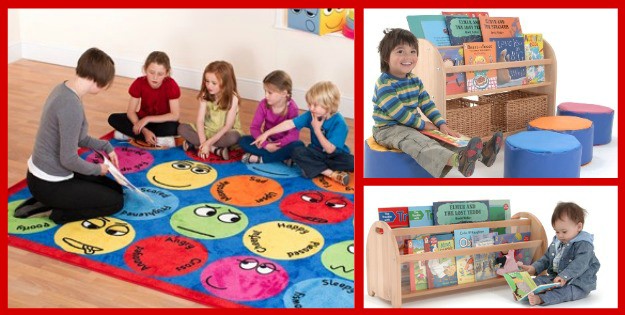
The ability to read and write is a fundamental skill that is used throughout life. From reading for pleasure to self-education, to writing to express your thoughts, ideas and feelings. These core literacy skills allow us to make sense of the world through language.
As with many skills, early years settings can play a significant role in encouraging a love of literacy. And one way to do that is by developing a literacy rich culture.
Let me explain…
Weaving literacy into the fabric of your setting
When planning the layout of your setting, it’s very tempting to segregate language and literacy areas – in much the same way as you create construction zones, a home corner and an arts and crafts area. Creating separate zones for specific types of play can help improve concentration and also helps children to organise their thoughts and ideas.
It’s good planning practice to have a dedicated reading/literacy area where children can go to immerse themselves in books or mark making. For example:
- A hideaway den can create a snug, exciting place for children to explore books and stories
- A large, colourful rug can create a collaborative space where children can enjoy stories together
- Easily accessible bookshelves can encourage children to select books and stories that catch their eye
- Easels or painting panels are ideal tools to promote mark making and letter formation
However, there’s a risk to only proving literacy-related materials in a dedicated zone. If children find books ‘boring’ then potentially they may be discouraged from engaging in these learning opportunities – and clearly this can have a negative impact on a child’s ability to discover language and literacy.
So instead, why not allow literacy and language to bridge different types of play and broaden the learning opportunities available?
Create a culture – incorporate literacy opportunities throughout your setting
As we know, children learn through play. In turn, self-directed and structured learning can help children develop a wide range of skills across a broad curriculum. And it’s for this reason that a literacy rich culture can be so effective. After all, if children are encouraged to engage in literacy-related play, their skills (and love for language) naturally grow.
Of course you can’t force books onto children. In fact, sending a child to the reading corner (if that’s not what they want to do) can be detrimental and turn reading into a negative experience.
So instead of segregating out reading and writing, incorporate these skills into every play zone. In turn, literacy becomes a natural part of all the other play activities that children enjoy. In short, you begin to create a literacy rich culture that can help children develop that all-important love for language.
Here are some easy to try suggestions:
- Label everyday objects around the setting so that children begin to associate letters with items
- Make relevant books available in the role-play area
- Encourage children to read stories to dolls in the home corner
- Offer mark-making equipment outside. For example, use sticks to draw in the sand and earth
- Ask children to tell you the stories they’re creating when playing in the construction or small world areas.
How have you created a literacy rich culture?
How do you incorporate reading and writing into outdoor play, construction and role play? Please leave your comments below.

Your article helped me a lot, is there any more related content? Thanks!
Thanks for sharing. I read many of your blog posts, cool, your blog is very good.